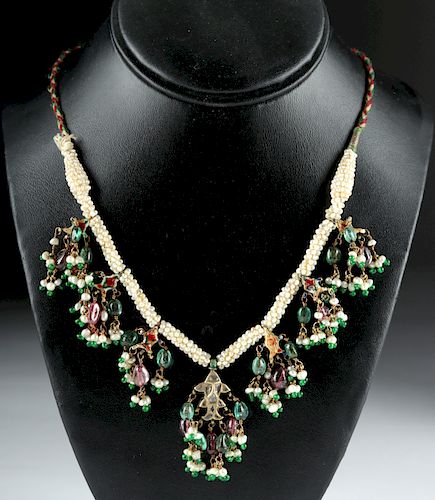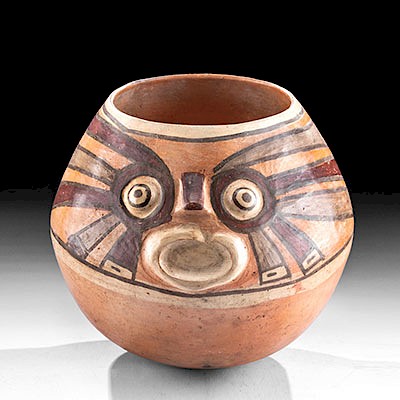19th C. Indian Necklace - Gold, Seed Pearl, & Gemstones
Lot 62e
About Seller
Artemis Gallery
686 S Taylor Ave, Ste 106
Louisville, CO 80027
United States
Selling antiquities, ancient and ethnographic art online since 1993, Artemis Gallery specializes in Classical Antiquities (Egyptian, Greek, Roman, Near Eastern), Asian, Pre-Columbian, African / Tribal / Oceanographic art. Our extensive inventory includes pottery, stone, metal, wood, glass and textil...Read more
Categories
Estimate:
$4,000 - $6,000
Absentee vs Live bid
Two ways to bid:
- Leave a max absentee bid and the platform will bid on your behalf up to your maximum bid during the live auction.
- Bid live during the auction and your bids will be submitted real-time to the auctioneer.
Bid Increments
| Price | Bid Increment |
|---|---|
| $0 | $25 |
| $300 | $50 |
| $1,000 | $100 |
| $2,000 | $250 |
| $5,000 | $500 |
| $10,000 | $1,000 |
| $20,000 | $2,500 |
| $50,000 | $5,000 |
| $100,000 | $10,000 |
| $200,000 | $20,000 |
About Auction
By Artemis Gallery
Dec 5, 2019
Set Reminder
2019-12-05 10:00:00
2019-12-05 10:00:00
America/New_York
Bidsquare
Bidsquare : Ancient / Ethnographic - Holiday Edition
https://www.bidsquare.com/auctions/artemis-gallery/ancient-ethnographic---holiday-edition-4710
What to give this holiday season? Ancient & Ethnographic Art of course! Our special Holiday auction features hundreds of unique finds from all over the world. Artemis Gallery info@artemisgallery.com
What to give this holiday season? Ancient & Ethnographic Art of course! Our special Holiday auction features hundreds of unique finds from all over the world. Artemis Gallery info@artemisgallery.com
- Lot Description
Central Asia, India, Rajasthan, ca. mid to late 19th century CE. A gorgeous necklace comprised of hundreds of woven seed pearls with six small and one larger 12 karat gold hanging fish decorations studded with diamond slices (known as polki) on one side and, for the six smaller ones, enamel on the other side, in the style known as kundan/meenakari. Below the fish, each is further accented with short dangles of fine drops of emeralds, lavender-colored spinels, and seed pearls. All hang from a braided gold, cream, red, and green string that ends in a tassel, with a small bauble of thread at the back to hold it close to the neck when worn. Length of strand: 29" L (73.7 cm); size of largest fish: 0.85" H (2.2 cm)
Polki diamonds are among the oldest forms of cut diamonds, and originated in India. They are currently enjoying a comeback in fashion. Their appeal, according to London-based jewelry designer Sally Agarwal, speaking to the Gemological Institute of America in 2016, "is that they generally are cut to follow the original rough stone so no two are alike and they impart a distinctiveness that makes each piece unique... They are very flattering to the wearer because the light they give off is much softer compared to the sparkle of modern cuts." This style originated sometime in the medieval period, with Indian jewel cutters learning how to use emery and diamond powder to make rough cuts of the incredibly hard stone. Even after Indian artisans learned European jewel cutting techniques in the 19th century, they continued to cut "polki" style diamonds for wedding jewelry.
Kundan is one of the oldest forms of jewelry made and worn in India. It is a method of gem setting, and is often paired with meenakari, a fusion of colorful minerals to create enamel, so that a piece of jewelry has two equally beautiful surfaces - one with the flashing kundan set gems, one with bright meenakari enamel. Jaipur, the capital of Rajasthan and once the seat of the royal family that controlled the region, is the center of the kundan craft, with much of it coming from the famous Johari Bazaar.
Provenance: ex-private Indian collection
All items legal to buy/sell under U.S. Statute covering cultural patrimony Code 2600, CHAPTER 14, and are guaranteed to be as described or your money back.
A Certificate of Authenticity will accompany all winning bids.
We ship worldwide and handle all shipping in-house for your convenience.
#138076A few of the seed pearls on the sides are missing - perhaps ten or so. Braided threads show light signs of wear. Otherwise in excellent condition, with light patina on the gold surfaces.Condition
- Shipping Info
-
All shipping is handled in-house for your convenience. Your invoice from Artemis Gallery will include shipping calculation instructions. If in doubt, please inquire BEFORE bidding for estimated shipping costs for individual items.
-
- Buyer's Premium



 EUR
EUR CAD
CAD AUD
AUD GBP
GBP MXN
MXN HKD
HKD CNY
CNY MYR
MYR SEK
SEK SGD
SGD CHF
CHF THB
THB














